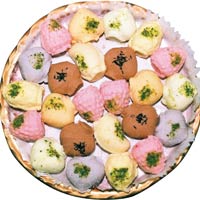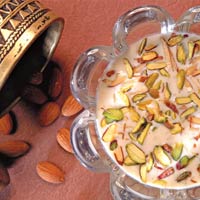I excitedly asked for the ones topped with the extra almonds and raisins. The laddoo was just an appetiser. The heady aroma directed me to the dining table, where an array of sweetmeats like kaju barfi, kheer and gulab jamuns made my eyes glisten and stomach rumble.
This is the day each year that my diet goes for a toss, and stays out of the window till the New Year is well settled. It is actually believed that eating good food, particularly sweets ensures a year filled with happiness. Perfect excuse!
A few days running into the festival, the kitchen is stocked up with the choicest ingredients like kesar, badam, pista, khoya, ghee, milk to make the sweet dishes.
The festivity at my home would begin even while I was sleeping--with the women preparing traditional delicacies from the wee hours of the morning.
Some Hindus fast two days before the festival, no doubt to be able to eat all they can on Diwali. They break their fast with a sweet dish called lapsi--warm and sweet porridge prepared with cracked wheat, sugar and ghee.
 If you are in Mumbai or anywhere in Maharashtra in fact, sample the sheera, which is often served as prasad after the puja. Diwali is incomplete without eating sheera, which has a fudge-like texture and is made with saffron, cardamom, raisins and nuts and served warm.
If you are in Mumbai or anywhere in Maharashtra in fact, sample the sheera, which is often served as prasad after the puja. Diwali is incomplete without eating sheera, which has a fudge-like texture and is made with saffron, cardamom, raisins and nuts and served warm.
On Diwali, the varieties of sweets and savouries prepared are endless. People love their regional sweets like chivda and karanji in Maharashtra, sandesh, rasagulla and chenna payesh in Bengal, mysore pak and murrukku in Tamil Nadu and the universally cherished kheer.
The best part of the bhog served after Kali Puja in Kolkata is the khichri that is served with ghant (mixed vegetables).
Each family has its own recipes passed down over several generations. My neighbour, a lady from Bihar was famous for her motichur laddoos. These laddoos are considered auspicious as they are supposed to be Lord Ganesh's favourite.
Reciprocating my neighbour's kind gesture, my mother would send me with a bowl of melt-in-the-mouth rasmalai--sugary cream-coloured balls of cottage cheese soaked in sweetened and thickened milk.
Our Maharashtrian neighbour would gift us a plateful of anarse--flattened cookies made with rice flour and jaggery. She would put her heart into preparing this time-consuming treat. Other accompaniments on the tray would usually be karanji or gujjia--sweet flour dumplings filled with stuffing and deep fried.
 Being a Maharashtrian she used dry coconut, sugar and poppy seeds as filling for karanji, whereas people in North India use a concoction of khoya, sugar, almonds rose water and cardamom powder for the filling.
Being a Maharashtrian she used dry coconut, sugar and poppy seeds as filling for karanji, whereas people in North India use a concoction of khoya, sugar, almonds rose water and cardamom powder for the filling.
These days nobody has the time or the patience to prepare sweets from scratch and many families choose the easier way--to buy them or have it prepared by a halwai.
While I still enjoy eating during Diwali, of course the rich flavour of those homemade sweets left on my tastebuds in my childhood, still lingers somewhere in my mind.
Courtesy: Travel Plus

